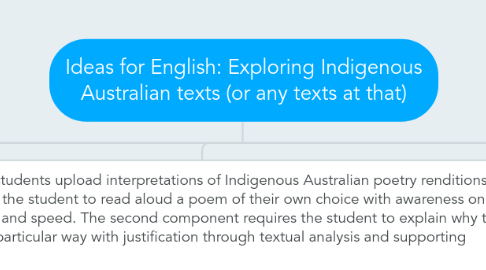Ideas for English: Exploring Indigenous Australian texts (or any texts at that)
by Clea Savinne

1. Maintaining a weekly blog of what they have learnt after each lesson allows students to reflect on their learning and articulate it in 'digital speak'. It encourages them to investigate other digital resources of relevance and begin to build an online world of public knowledge.
1.1. SAMR: Substitution - Modification level, depending on ability of student.
1.2. The construction of typed text requires different cognitive tools to written application. This activity encourages the student to adopt essential ICT communication skills and to adopt a language style appropriate to a specific digital audience (Melbourne Declaration, AusVELS)
1.3. Reflection encourages critical analysis and higher order thinking. Regular entries track progress of opinions/ideas and knowledge, discovering how these may change over time and why.
1.4. This pedagogy draws from the idea that students need to be active participants in ICT learning, i.e. input (read, listen, interpret) needs to be complemented with output (make, communicate, explore and evaluate). Therefore the blog requires students to create, construct and communicate their knowledge in a digital environment where their posts represent active participation with a tangible product.
1.5. AusVELS: Helps students become ethical, thoughtful, informed and active members of society.
1.6. Blog links and ideas: http://juliazofiaa.blogspot.no/ http://jamiehalvorson.com/blog/ http://brontesblog.global2.vic.edu.au/
2. Using Soundcloud, students upload interpretations of Indigenous Australian poetry renditions. First component requires the student to read aloud a poem of their own choice with awareness on choice of tone, volume, pitch, and speed. The second component requires the student to explain why they articulated it in this particular way with justification through textual analysis and supporting resources.
2.1. SAMR: Modification. This allows for task redesign with direct modification from the student.
2.2. Encourages student voice
2.3. https://soundcloud.com/
2.4. Articulation and vocal presentation for a particular audience
2.5. AusVELS: Students learn to listen to, read, view, speak, write, create and reflect on increasingly complex and sophisticated spoken, written and multimodal texts across a growing range of contexts with accuracy, fluency and purpose
3. Students use Mindmeister (or similar mindmapping tool) to collaborate on topic ideas and concepts. This is effective at the beginning of a new topic when identifying prior knowledge, ZPD and learning needs in order to implement correct pedagogical interventions. Files can emailed between class and/or printed to form the basis of topic knowledge
3.1. SAMR: Augmentation
3.2. http://www.mindmeister.com
3.3. Allows structured organisation of ideas and concepts. Easily available for all students to access and keep on file as a resource
4. Students collaborate in small groups to create a Wiki page based on an area of interest within the topic field, becoming active participants and informed sharers of knowledge.
4.1. SAMR: Transformation of knowledge through redefinition. Works at higher levels of cognition
4.2. Encourages group interaction and cooperation. Supports constructivist learning through shared knowledge and ideas. Student voice essential in the construction of resource.
4.3. Learner (student) as designer and teacher
4.4. Students critically analyse/evaluate the credibility of primary and secondary sources
4.5. AusVELS: Individuals learn to analyse, understand, communicate with and build relationships with others and with the world around them
5. Students use Proboards as digital platform to discuss topics/issues from class. It allows them to become accustomed to public discussion and to critically review what they say before they say it. The teacher acts as facilitator to ensure the conversation remains appropriate to task and audience, whilst students are able to view all comments and have them on file for future reference.
5.1. SAMR: Modification. Whilst only working at enhancement level, this task encourages non ICT cognitive development.
5.2. Encourages student voice
5.3. http://www.proboards.com/
5.4. AusVELS: Students appreciate, enjoy and use the English language in all its variations and develop a sense of its richness and power to evoke feelings, convey information, form ideas, facilitate interaction with others, entertain, persuade and argue
5.5. AusVELS: Students understand how Standard Australian English works in its spoken and written forms to create meaning


